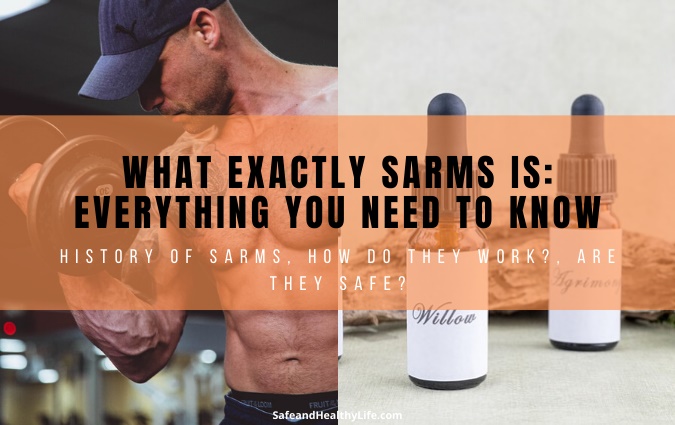
SARMs are essentially a class of androgen receptors that display selective androgenic signaling. If this definition threw you off, here’s a simpler explanation for you.
SARMS are often marketed as ‘safe steroids’. However, since these are relatively in their initial stages of research and development, their long-term safety is largely unknown.
Despite that, the past decade has seen a great deal of rising in the popularity of SARMs.
These are often compared to steroids; mostly because of the similarities in their working mechanism. But, they are completely different.
Although they both work by binding to androgen receptors which trigger a series of changes in the DNA to improve muscles; SARMs are not as dangerous.
Anabolic steroids are linked with liver damage and increasing the odds of developing prostate cancer.
That is why bodybuilders around the world have been looking for a safe alternative – something that could help them build muscles without all these dangerous side-effects.
This is where SARMs are supposed to come in.
History of SARMs
SARMs go back to the 1940s. This is when the efforts to develop steroidal SARMs began. The efforts were based on a series of modifications done on a testosterone molecule.
The products you see in modern times are a result of the independent efforts input by the University of Tennessee and Ligand Pharmaceuticals.
These two names are the pioneers of steroidal SARMS and their collective efforts are what provided the earliest foundations for their discovery and later their development. Ever since the discovery of SARMs, 6 different pharmacophores have emerged.
They are – quinolinones by Ligand Pharmaceuticals, aryl-propionamide by GTX, Inc., Tetrahydroquinoline analogs by Kaken Pharmaceuticals, Inc., bicyclic hydantoin by BMS, John and Johnson, Azasteroidal derivatives by Merck, and 4 different derivatives by GSK.
It’s possible that there exist some additional categories. But, due to limited research and material available – it’s hard to tell.
Today, a large number of pharma companies are geared towards making their own version of SARMs. If you want to explore these, you can visit Select Sarms; the online store.
How Do They Work?
Even though SARMs mimic the working mechanism of anabolic steroids; they couldn’t be poles apart. The two are entirely different from one another.
Unlike steroids and hormonal therapies, a SARM supplement works on muscle tissues only.
This is why scientists feel that these might be a safer alternative to steroids. However, since there is no concrete evidence available and since the research is still in its early phase, the safety profile of these supplements is still largely unknown.
Scientists are also not sure whether or not the general population should consume them. They are, however, gaining a lot of popularity in the bodybuilding community.
The basic idea is these supplements work much in the same way as testosterone does in the body.
However, unlike anabolic steroids or synthetic steroids, SARM works directly by targeting the skeletal muscle.
Anabolic-androgenic steroids can bind to any receptor in the body. This can affect anything from the heart, brain, liver, to the reproductive system.
But, SARMS are safe because they work ‘selectively’. They target only skeletal muscles.
They have shown great potential for patients with severe medical conditions. For example, in cancer patients who lose a lot of muscle as an aftereffect of exposure to radiation and chemotherapy – these supplements helped fight muscle loss.
In fact, the earliest medical studies and trials revolved around studying their potential for helping people with cancer.
However, bodybuilders have started using them for better strength and higher muscle mass.
Their popularity among gym-goers and bodybuilders is based on the theory that SARMS fight muscle loss. While it sounds logical, researchers feel it’s too early to know if they really do help with building muscles.
SARMs have surely proven helpful in cancer patients to retain some muscle mass. Whether or not it helps them get any stronger to help them through their everyday chores is still not established. But, they have proved effective in terms of maintaining muscle mass and avoiding muscle loss, post-cancer treatment.
Are They Safe?
The jury is still out to give confirmation on whether or not there could be any potentially dangerous side-effects, especially if we talk about their long-term usage. The safety data about SARMS is still not available. They are marketed and sold as ‘supplements’.
In the absence of clinical trials and the lack of pending approval in countries like Europe, the US, and Australia, most SARMs are bought online and you need to find the best place to buy SARMs.
This is where things get tricky. In the absence of proper regulation, there’s always the issue of quality check.
Unless you can vouch for the vendor who made them, a lot of the products could contain fake ingredients, or worse; even dangerous ingredients. The risk of products containing anabolic steroids is always there which puts the responsibility of vouching for product quality on users.
Are SARMs legal?
For now, they are. However, they are not approved or regulated by the FDA. In fact, the Food and Drug Association has even issued a warning regarding their usage.
However, if you have set your mind on trying them out, be sure to perform due diligence. Buy from a reputable and trustworthy vendor.
Final Words
From a medical standpoint, SARMs have exhibited great potential. But there’s no way to tell if a regular user should consume them and whether or not they could help you build muscles and gain strength. But, with all that’s said and done, SARMS sales are increasing with each passing year.
About The Author:
Stacey Smith is a freelance health writer. She is passionate to write about women’s health, dental health, diabetes, endocrinology, and nutrition and provides in-depth features on the latest in health news for medical clinics and health magazines.




